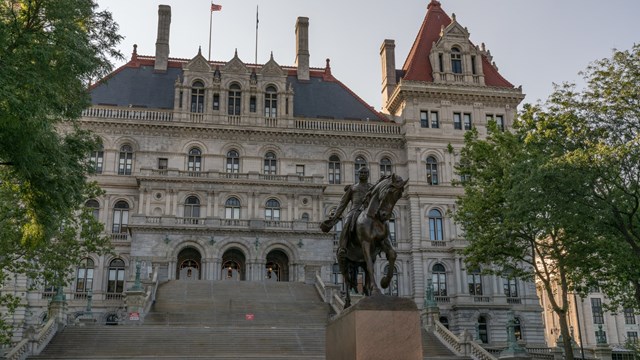Trust. It's a word often heard when board members and shareholders of Big Six, a 982-unit co-op complex in Woodside, Queens, talk about their former managing agent, Richard Stone, and what they think went wrong. Essentially, they say, we trusted the wrong man. Why did individual shareholders, mostly retirees, invest up to $80,000 each in a shopping center expansion that ballooned in cost and has yet to be finished? Why did board members allow themselves to be convinced that the expansion was in the co-op's best interests?
Everybody trusted him, says Hal Schimel, a long-time resident of Big Six.
He was good, explains Richard Fischbein, a partner with the law firm of Fischbein, Badillo, Wagner and Itzler, who is representing the board in a civil suit filed last month against Stone and others allegedly involved in the scheme. There's no question that he was good at keeping board members in the dark.
Exactly what happened at Big Six, where Stone was the managing agent for 25 years, remains shrouded in mystery. But the gist of it is that millions of dollars of the co-op's money, as well as nearly two million dollars loaned by individual shareholders, was spent on expanding the complex's shopping center, a project that spiralled out of control and has yet to be completed. The situation is further complicated by allegations that much of the money went toward contracting projects at other properties owned or operated by Stone.
Big Six, a Mitchell-Lama co-op that is home to mostly retirees and working-class families, is now $27 million in debt, says Fischbein, a sum that includes $1 million owed to the city in mortgage payments, $4 million in real estate taxes, water and sewer charges and $10 million in construction loans.
Hints and Allegations
While the recent allegations against Stone may have come as a surprise to the co-op and condo industry, there are residents in the building who say they suspected all along.
I'm an accountant, and when I saw ten percent interest on investing in the expansion, I knew it was too much, says Schimel. I told people not to invest. They didn't listen. They trusted him, even with the shopping center expansion proposal.
According to Diana Cort, Richard controlled the board and people allowed it to happen. Roland Solomon (the former board president) acted as though he was loyal more to Richard Stone than anything else, including Big Six.
Stone had a history with us for 25 years; we had some very successful projects with him, like our cogeneration plant. He did some good for us, explains Cort. But her feelings changed when she became treasurer. When I noticed some things, like a lack of paperwork on purchases, I'd ask him and he'd say, 'Don't worry your pretty little head about it, Diana.' He wanted me to sign checks without back-up information, without anything. He always used the word 'in-house', 'we'll do it in-house' it was his way of saying he could save us money.
The shopping center expansion was first presented to residents of the complex in 1989, by Stone and Roland Solomon, then board president of Big Six. The proposal was to add a 45,000-square-foot second story to the existing shopping center. Notices were distributed explaining that the expansion would help the complex avoid a maintenance increase.
I don't think a lot of residents understood it was a vote, says Hal Schimel. It was a piece of paper sent to everyone in the building saying if you don't vote for the expansion, the [maintenance] will have to be raised. At the bottom it said, 'I am against the expansion and prefer the increases.' I think most residents thought [Stone] just wanted opinions.
Millions of Dollars Borrowed
To finance the project, Stone took out several bank loans in the co-op's name, totalling about $10 million. He borrowed an additional $1.85 million from more than 200 shareholders in the form of debentures, according to Jonathan Young, an attorney working with Fischbein. Debentures are unsecured bonds that are backed solely by the virtue of the issuer, in this case Stone. The bonds yielded ten percent interest and seemed like a good idea for many residents at the time.
Suspicion was cast on Stone when he approached the National Cooperative Bank (NCB) in an effort to obtain another loan, this time to pay taxes owed by the co-op. Because Big Six is a Mitchell-Lama co-op, it is under the auspices of the New York City Department of Housing Preservation and Development (HPD). The building makes mortgage payments directly to HPD because the city holds the building's underlying mortgage, and HPD is responsible for annual financial audits of the complex. Thus, in checking Big Six's finances, NCB requested an HPD audit, which was given to the board of directors and Stone in June 1994. The audit revealed signs of mismanagement and dubious handling of funds, and was turned over to investigators.
Shortly thereafter, Stone came to me seeking representation, says Fischbein. When I saw the word 'debenture', I asked, 'what's that?' When I was told it meant borrowing from people in the building, I told Stone I wouldn't represent him but would represent the board.
Stone subsequently retained attorney Roger Adler to represent him, but both Adler and Stone refused to be interviewed for this article.
On Fischbein's recommendation, an independent accounting firm, Prisand & Newman, was brought in to make a more thorough examination of Big Six's financial situation. The results were startling. We found no backing for any bills paid; excessive labor costs; payments to employees in excess of how much they worked, says Carole Newman, a partner with the accounting firm. There was payment to employees who weren't there.
What was also uncovered was that a number of companies working on the shopping center expansion were owned by Stone, says Fischbein. One such company, known as Indecom, is suspected of being an outlet for construction work done outside of Big Six and paid for by the co-op. Stone, the suit contends, was paid as construction manager by other co-ops the companies worked for.
The civil suit filed in March names, in addition to Stone, a number of supposed front-companies, all allegedly owned by Stone. It also names Roland Solomon, Big Six's former board president, two contractors, an attorney and others, all suspected of defrauding the co-op of at least $10 million, according to the Manhattan District Attorney's office.
Earlier Suspicions Dismissed
As early as 1990, at least some residents of Big Six had suspicions that all was not well with the construction project. That year, a similar lawsuit was brought by shareholder Maxine Jacobowitz against Stone and the board of directors at the time. The suit alleged that funds earmarked for the construction of the shopping center expansion were being diverted from Big Six by Stone to other unrelated projects for his own benefit.
Jacobowitz presented HPD with an affidavit signed by Ralph Pesce, the construction superintendent on the upper level expansion. Among other allegations, Pesce said that Stone placed his son on the construction payroll at a time when his son was in England and that Stone had used Big Six employees to do work for other Mitchell-Lama cooperatives and had Big Six pay for the work. Jacobowitz sought, among other things, to force HPD to investigate move in and move out charges Stone was placing, which HPD states are illegal, and look into the alleged wrongdoings pertaining to the shopping center expansion.
Although the case was dismissed for lack of evidence, HPD recommended at the time an independent auditor, Lawrence & Co., to investigate Jacobowitz's claims. At the conclusion of its audit, Lawrence & Co. issued an opinion that Big Six's schedule of construction costs was presented fairly. In effect, the audit said: No wrongdoing found.
Indeed, evidence is difficult to come by. According to Jonathan Young of Fischbein Badillo, an architect named Louis Colalillo was the original designer of the expansion project. Colalillo confirms this, adding that he fulfilled his contract responsibilities to Big Six. He further claims that, Those designs were filed and approved with the DOB (the New York City Department of Buildings, which issues all building permits) in 1989. According to the DOB, however, the only filing for that address was in 1988 on an Applications and Alterations form that was signed by an Ed Steck of JCA Associates. The form was approved by the DOB and signed off in the owner box by Richard Stone. Attempts to reach JCA were not fruitful.
Sometime after 1989, Colalillo was dismissed and, according to legal sources, an Argentinian architectural student was brought on to handle the job.
Where Was the City?
I'd like to know where HPD was when Big Six fell behind in mortgage payments, says Charles Rappaport, president of the Federation of New York Housing Cooperatives (FNYHC), a Queens-based organization that helps educate co-op owners, and specializes in Mitchell-Lama housing. New York City is the supervising agency for Mitchell-Lama co-ops. HPD gets the reports; why didn't they notice anything wrong? Somewhere in the city bureaucracy, there's a glitch. Either way, they didn't look hard enough, Rappaport asserts.
According to a spokesperson for HPD, Lawrence & Co. found everything to be okay in their audit. HPD contends that they did well by the co-op and worked with the information given to them.
Young sees things differently: [Lawrence & Co.] did a completely inadequate audit for HPD. In it, they wrote there was $45,000 needed to complete the shopping center expansion; $5 million later, it's still not done. A complaint was filed by Fischbein Badillo with the New York State Supreme Court against Jack Lawrence & Co. on February 27, 1995 charging that, Lawrence & Co. failed to recognize and inform the board of directors of Big Six and HPD that the housing cooperative was being systematically looted by Stone. In addition, the complaint makes note that, Lawrence & Co. affirmed the accuracy of the fraudulent records Stone compiled.
NYARM and the Industry React
In addition to being property manager for Big Six since 1969, Richard Stone was president of the New York Association of Realty Managers (NYARM) for over ten years. NYARM is a professional organization that, among other things, seeks mandatory licensing for managing agents, holds an annual trade show and certifies real estate managers. Stone stepped down as president last December because, according to Leonard Jones, current president, NYARM's bylaws are very strict about only active real estate managers being president. Since Stone had been forced to resign from Big Six last November, he no longer met those requirements, Jones explains.
NYARM has been around for over 20 years, says Jones. We have several hundred members. We stand for honest and intelligent property management. We will continue to do that. None of the allegations are being made against NYARM, but, unfortunately, this will affect us all. The industry goes through this once in a while. That's why we stress licensing for managers. An organization like NYARM certainly can't police, we can just inform. We wish Richard well. Not much we can do for him now but we do wish him well.
When asked about the sudden resignation of two prominent figures from NYARM's board, Leslie Kaminoff, president of AKAM Associates, and Anita Sapirman, president of Saparn Realty, Jones answered, Initially, I was surprised. The board of directors have worked so well together. Leslie and Anita felt their profiles were high. They thought it was a good business decision to step down. It's understandable. When things settle down, they're welcome to come back.
Marcia Taranto, president of Taranto & Associates, a residential management firm, and a member of NYARM, says, It would be a shame to lose NYARM because of this. She goes on, One member should not reflect an entire organization. Even if Stone is charged, he's just one person accused of wrongdoing. As far as I know, none of his alleged illegal activity was through NYARM. I have no intention of leaving the organization.
Who Really Loses?
While the inquiry into Richard Stone and the activities at Big Six continues at the Manhattan District Attorney's office, residents and shareholders prepare for the worst. Schimel is already awaiting a large rent increase and smiles at the thought, They don't have much choice, do they?
Accountant Carol Newman doesn't paint a pretty picture of the co-op's options or its present financial condition, either: Big Six is $27 million in debt. The building doesn't have money to pay real estate taxes or the underlying mortgage held by the city. At this point, there will be maintenance increases for the building just so it can break even on an operating basis. There is no money in Big Six.
And Big Six's next step? There are some options. Negotiate with New York City to restructure debt or go elsewhere to refinance. There's really not much else they can do, says Newman, who confirmed that Big Six's board had retained her as their new accountant. The complex has also hired a new managing agent, Kreisel, a Manhattan management firm that manages over 150 co-op and condo buildings in the New York area. Although representatives at Kreisel confirmed that they had been hired by Big Six, they refused to comment on the situation until more information has been obtained.
As for the investors in the shopping center expansion, Newman says that the current board will do everything it can to refund those investors and bring Big Six back on line. I think they're glad it's now out in the open. There's new management at the building and the board is ready to deal with these issues and try to work things out, she says.







Leave a Comment